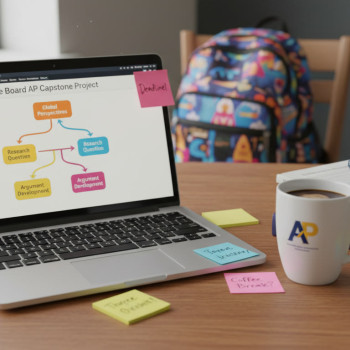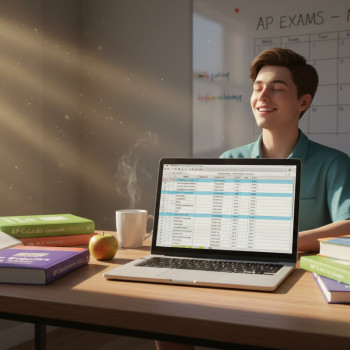KAIST/POSTECH: STEM with AP — A Warm Roadmap for Ambitious Students and Parents
Thinking about KAIST or POSTECH? If you’re a student who loves math, physics, computer science or engineering, you’re already in great company. These two South Korean institutions are magnets for curious, hardworking minds — and Advanced Placement (AP) courses can be an excellent way to prepare academically, demonstrate readiness, and shape a compelling application. This blog is written for both students who are burning with curiosity and parents who want to help without doing the homework for them. We’ll cover smart AP choices, study strategies, how to present your achievements, and where personalized help (like Sparkl’s tailored tutoring) fits naturally into the journey.
Why AP courses matter when targeting top STEM schools
AP classes do three important jobs for ambitious STEM applicants:
- They build academic rigor — taking AP Calculus, AP Physics, or AP Computer Science shows universities you’ve challenged yourself in key subjects.
- They provide objective measures — AP exam scores give admissions teams standardized evidence of your competency across internationally comparable benchmarks.
- They create a coherent STEM narrative — a sequence of AP science and math courses tells a story about your academic focus, not just scattered interests.
Keep in mind that while APs are widely recognized, KAIST and POSTECH evaluate applicants holistically. Strong AP results help, but they’re one part of a bigger picture that includes research, projects, interviews, essays, and extracurricular depth.

Which AP subjects give you the most leverage for KAIST/POSTECH?
Not all APs are equal for a STEM profile. Choose courses that align tightly with the major you want to pursue and that show both depth and breadth in STEM fundamentals.
- Essential core: AP Calculus (AB or BC) and AP Physics (C: Mechanics and/or Electricity & Magnetism). These are centerpiece courses for engineering and physical sciences.
- High-impact complements: AP Computer Science A (for CS/SE aspirants), AP Chemistry (for materials or chemical engineering), AP Biology (for life sciences), and AP Statistics (useful across many majors).
- Advanced evidence: If available, AP Research and AP Seminar (AP Capstone) can demonstrate independent inquiry and research communication — skills highly valued at research-driven universities.
Plan your APs across three years if possible: begin with one strong science and a math course in 10th grade, progress to Calculus and another lab science in 11th grade, and aim for advanced APs, exams, or research projects in 12th grade.
How to build an AP curriculum that aligns with KAIST/POSTECH goals
Your AP plan should be manageable while still signaling intellectual ambition. Here’s a sample three-year trajectory for a student targeting engineering or computer science pathways.
| Year | Focus | Recommended APs / Activities |
|---|---|---|
| Grade 10 | Foundation | AP Statistics or AP Computer Science Principles; start pre-Calculus/Calculus sequence; join math/robotics club |
| Grade 11 | Depth | AP Calculus AB/BC; AP Physics 1 or AP Physics C if available; coding projects or local research internship |
| Grade 12 | Demonstration | AP Physics C (if not yet taken); AP Chemistry or AP Biology if relevant; AP Research / capstone project; AP exams in May |
Quality over quantity: how many APs should you take?
More APs don’t always equal better applications. Admissions officers look for sustained excellence: consistently high grades in the most relevant courses, not a laundry list of half-mastered subjects. A strong, focused AP profile — for example, Calculus BC + both AP Physics Cs + AP Computer Science A for a prospective CS major — speaks louder than taking ten unrelated APs with middling performance.
Study strategies to succeed in APs and beyond
Succeeding in APs requires study habits that go beyond last-minute cramming. The habits you form while preparing are the same ones that will help you flourish at a demanding university like KAIST or POSTECH.
1. Build a concept-first foundation
AP exams reward conceptual clarity. Instead of memorizing formulas, ask why a technique works, visualize physical phenomena, and connect algorithms to real problems. For example, when studying kinematics in AP Physics, pair equations with sketching motion graphs — this helps you translate abstract formulas into intuition.
2. Practice deliberately with past-style problems
Work on authentic, AP-style questions under timed conditions. For coding, implement small projects and algorithm problems to apply concepts. Use error logs: when you miss a question, record why and track progress over weeks so you don’t repeat mistakes.
3. Reinforce through teaching and projects
Explaining a topic to someone else is a powerful test of understanding. Start a study group, tutor a peer, or create a short video lesson. Projects — building a small robot, a simulation, or a web app — turn knowledge into demonstrable skills that shine in interviews and essays.
4. Integrate exam strategy and mental stamina
The AP exam is a marathon. Build stamina with full-length practice exams, refine pacing, and become comfortable moving between multiple-choice speed and free-response depth. On test day, prioritize clarity in answers: neat diagrams and clear reasoning can earn crucial partial credit in AP free responses.
Crafting a compelling application narrative
KAIST and POSTECH seek students who have both academic potential and intellectual curiosity. APs help establish academic potential — your application narrative should weave AP success with authentic activities that show curiosity in action.
Make APs a backbone, not the whole story
Use APs to demonstrate mastery, then showcase how that mastery translated into action: research experiments, coding contributions, math competitions, open-source work, or internships. A student who pairs AP Physics C scores with a physics research project or a published coding portfolio demonstrates both knowledge and initiative.
Use personal statements to show context and growth
Essays let you explain why you chose those APs and what you learned beyond grades. Reflect on obstacles (time management, conceptual hurdles), how you overcame them, and how those experiences shaped your future ambitions. Admissions committees value maturity and reflection as much as raw results.
How to use test scores and AP results strategically
High AP exam scores are persuasive. They provide external validation of your preparation. When you do well, include them prominently in your application materials. If a score doesn’t reflect your understanding, contextualize improvement elsewhere — for example, high classroom grades, project outcomes, or later exam retakes can show upward momentum.
Timing your exams and grades
- Take foundational APs earlier (like Statistics or Intro CS) and time Calculus/Physics for when you’ll have the strongest preparation.
- Plan AP exams for May of the year before application or senior year if you’re ready — strong results coming in senior year can still be persuasive, but some applicants prefer earlier APs so scores are available for application review.
Extracurriculars, research, and interviews — the difference-makers
For KAIST and POSTECH, depth matters. A meaningful research project, even at the high-school level, signals your readiness for undergraduate research culture.
Ideas for meaningful STEM extracurriculars
- Independent research or a capstone project: design a small experiment or software project and document your process and results.
- Competitions: math, physics, programming olympiads, or hackathons demonstrate problem-solving under pressure.
- Community STEM outreach: tutoring younger students, running coding workshops, or mentoring in robotics clubs shows leadership and communication.
Preparing for interviews and interviews’ expectations
Interviews often probe problem-solving and depth of interest. Practice explaining projects succinctly: what you set out to do, the challenges you encountered, what you learned, and what you’d do next. Being able to discuss technical details clearly — without jargon — is a major advantage.
How personalized tutoring can accelerate your AP and admissions progress
Many students find targeted support transforms effort into results. Personalized tutoring helps with a few key things:
- Filling conceptual gaps quickly, so that AP classes become launchpads rather than obstacles.
- Creating tailored study plans that balance schoolwork, AP prep, and extracurriculars.
- Providing practice tests, timed drills, feedback loops, and strategies for AP free responses and college interviews.
Sparkl’s personalized tutoring can fit naturally into this approach — offering 1-on-1 guidance, tailored study plans, expert tutors, and AI-driven insights to pinpoint weaknesses and accelerate improvement. When chosen carefully, a tutor becomes a coach: someone who clarifies concepts, models problem-solving, and keeps motivation steady.
Practical timeline and checklist — from sophomore year to application
Here’s a practical checklist that condenses the timeline and helps you stay focused. Use it as a living document and adjust for your school’s offerings and your personal pace.
| When | Focus | Action Items |
|---|---|---|
| Sophomore Year | Explore and plan | Start Calculus sequence or Pre-Calc, take 1 AP if ready, join STEM clubs, explore research ideas |
| Junior Year | Deepen and perform | Take AP Calculus and AP Physics; begin projects or internships; take full-length practice tests; consider a tutor if needed |
| Summer before Senior Year | Intensify | Work on a research project or coding portfolio, prepare for AP exams in May, refine personal statement ideas |
| Senior Year | Polish and submit | Complete APs and capstone; finalize essays; prepare for interviews; submit applications with strong project documentation |
Checklist — what admissions committees want to see
- Strong grades in challenging math and science courses (AP or equivalent).
- High AP exam scores in relevant subjects where possible.
- Clear evidence of sustained STEM engagement: research, competitions, internships, or portfolio work.
- Thoughtful essays showing reflection, resilience, and curiosity.
- Polished interview skills and the ability to explain technical work clearly.
Common pitfalls and how to avoid them
A few mistakes recur among talented applicants. Avoid these to keep your profile clean and convincing.
Pitfall 1: Spreading yourself too thin
Depth beats breadth. Rather than joining every club, focus on one or two activities where you can produce meaningful work or leadership.
Pitfall 2: Treating APs as only test-prep
AP classes are opportunities to build real foundations. Connect coursework to projects and research to show how classroom learning translates into exploration and innovation.
Pitfall 3: Waiting to get help
If you struggle with a concept, early intervention is crucial. A few targeted tutoring sessions can prevent months of lost time and keep your AP trajectory on track. Personalized tutors (including those from Sparkl) can diagnose gaps and create efficient study plans.
Real-world examples to inspire action
Here are two composite, anonymized examples (built from common student pathways) that show how APs and purposeful activities combine to create strong applications.
Example A — The Aspiring Materials Engineer
Profile highlights: AP Calculus BC, AP Physics C (both mechanics and E&M), AP Chemistry, a summer research internship at a university lab, and a senior capstone on advanced materials for energy storage. Scores: high AP exam scores in Calc and Physics; research produced a poster at a local conference. Narrative: This student used APs to gain rigorous grounding, then extended classroom learning into a lab environment — exactly the kind of trajectory KAIST or POSTECH would find compelling.
Example B — The Young Computer Scientist
Profile highlights: AP Computer Science A, AP Calculus BC, AP Statistics, coding projects (open-source contributions and a hackathon winner), and AP Research on algorithmic fairness. Narrative: APs provided credentials and structure; independent coding projects showed creativity and tangible output. A tutor helped refine algorithmic thinking and interview communication.
Final words: Your readiness matters more than a formula
KAIST and POSTECH look for students who combine strong fundamentals with curiosity and the ability to apply knowledge. AP courses are an excellent vehicle for building those fundamentals — but they’re most powerful when integrated into a thoughtful program of projects, research, and reflection.
For many students, a little personalized guidance can shorten the path between effort and results. If you’re unsure where to start or how to level up, consider targeted 1-on-1 support. Sparkl’s approach — tailored study plans, expert tutors, and AI-driven insights — can help you turn strong AP preparation into a clear, competitive application, while keeping the journey human, manageable, and inspiring.

Remember: there’s no single perfect recipe. What matters is consistent curiosity, thoughtful choices, and a willingness to iterate. Use APs to show what you can do, then let your projects and reflection show who you are. Good luck — the world of STEM needs your ideas.


















No Comments
Leave a comment Cancel